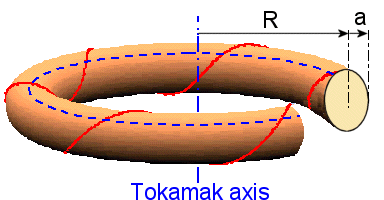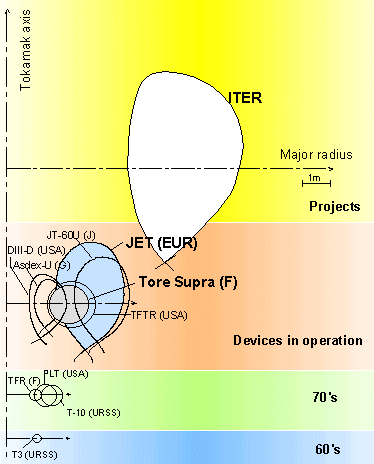|
The ITER project

5 - Project description
|
The increase in the size of Tokamak machines (plasma cross-section) over the course of time is shown
in the figure opposite. ITER will be a superconducting Tokamak of a size
as yet unequalled. Tore Supra, the CEA
superconducting Tokamak has demonstrated this technology. The use of superconducting magnets
permits long pulse operation. The chart below describes the main parameters of the project.

R=major radius of plasma
a=minus radius of plasma
. |
 |
| Parameters |
Tore
Supra |
JET
 |
ITER |
| Major radius of plasma (m) |
2.25 |
3 |
6.21 |
| Minor radius of plasma (m) |
0.7 |
1.25 |
2.0 |
| Volume of plasma (m3) |
25 |
155 |
837 |
| Plasma Current (MA) |
1.7 |
5-7 |
15 |
| Magnetic field (T) |
4.5 |
3.4 |
5.3 |
| Duration of pulses (s) |
minute(s) |
10 |
> 300 s |
| Type of Plasma |
D-D |
D-D / D-T |
D-T |
| Thermonuclear power (Pth) |
~ kW |
50kW/ 10MW |
500 MW |
| Q = Pth / heating power |
~ 0 |
~1 |
>10 |
| Neutron power at the edge |
20 W/m² |
60 kW/m² |
0.57 MW/m² |
Main parameters of Tore Supra, JET,
ITER
|
The main goal of ITER is the study of
burning plasmas, i.e. plasmas where heating is mainly provided by the alpha particles created from fusion reactions. The share of heating due to alpha particles amounts to hardly 10% in the best pulses achieved in the JET
 machine.
This share will be 60% in ITER. ITER will also be the first machine incorporating most of the technologies crucial for the preparation of
a futur current generating fusion reactor (plasma facing components, tritium management, robotics, tests of breeding blankets
etc.). machine.
This share will be 60% in ITER. ITER will also be the first machine incorporating most of the technologies crucial for the preparation of
a futur current generating fusion reactor (plasma facing components, tritium management, robotics, tests of breeding blankets
etc.).
|
View of ITER
(from ITER
 )
: move and click on a selected view )
: move and click on a selected view |
|
For further information
|
|